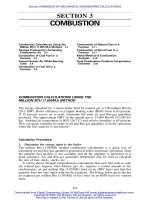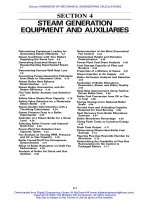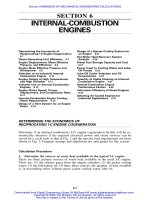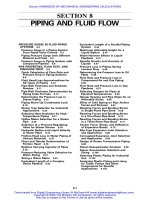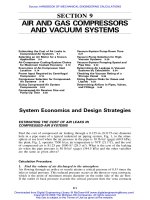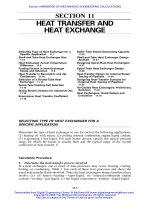Tài liệu Handbook of Mechanical Engineering Calculations P5 pdf
Bạn đang xem bản rút gọn của tài liệu. Xem và tải ngay bản đầy đủ của tài liệu tại đây (401.76 KB, 16 trang )
5.1
SECTION 5
FEEDWATER HEATING
METHODS
Steam-Plant Feedwater-Heating cycle
Analysis
5.1
Direct-Contact Feedwater Heater
Analysis
5.2
Closed Feedwater Heater Analysis and
Selection
5.3
Power-Plant Heater Extraction-Cycle
Analysis
5.8
Feedwater Heating with Diesel-Engine
Repowering of a Steam Plant
5.13
STEAM-PLANT FEEDWATER-HEATING CYCLE
ANALYSIS
The high-pressure cylinder of a turbogenerator unit receives 1,000,000 lb per h
(454,000 kg /h) of steam at initial conditions of 1800 psia (12,402 kPa) and 1050
Њ
F
(565.6
Њ
C). At exit from the cylinder the steam has a pressure of 500 psia (3445
kPa) and a temperature of 740
Њ
F (393.3
Њ
C). A portion of this 500-psia (3445-kPa)
steam is used in a closed feedwater heater to increase the temperature of 1,000,000
lb per h (454,000 kg/h) of 2000-psia (13,780-kPa) feedwater from 350
Њ
F (176.6
Њ
C)
to 430
Њ
F (221.1
Њ
C); the remainder passes through a reheater in the steam generator
and is admitted to the intermediate-pressure cylinder of the turbine at a pressure of
450 psia (3101 kPa) and a temperature of 1000
Њ
F (537.8
Њ
C). The intermediate cyl-
inder operates nonextraction. Steam leaves this cylinder at 200 psia (1378 kPa) and
500
Њ
F (260
Њ
C). Find (a) flow rate to the feedwater heater, assuming no subcooling;
(b) work done, in kW, by the high-pressure cylinder; (c) work done, in kW, by the
intermediate-pressure cylinder; (d) heat added by the reheater.
Calculation Procedure:
1. Find the flow rate to the feedwater heater
(a) Construct the flow diagram, Fig. 1. Enter the pressure, temperature, and enthalpy
values using the data given and the steam tables. Write an equation for flow across
the feedwater heater, or (H
2
Ϫ
H
7
)
ϭ
water (H
6
Ϫ
H
5
). Substituting using the
enthalpy data from the flow diagram, flow to heater
ϭ
(1
ϫ
10
6
)(409
Ϫ
324.4)/
(1379.3
Ϫ
449.4)
ϭ
90.977.5 lb/h (41,303.8 kg/h).
2. Determine the work done by the high-pressure cylinder
(b) The work done
ϭ
(steam flow rate, lb / h)(H
1
Ϫ
H
2
)/3413
ϭ
(1
ϫ
10
6
)(1511.3
Ϫ
1379.3)/3414
ϭ
38,675.7 kW.
Downloaded from Digital Engineering Library @ McGraw-Hill (www.digitalengineeringlibrary.com)
Copyright © 2006 The McGraw-Hill Companies. All rights reserved.
Any use is subject to the Terms of Use as given at the website.
Source: HANDBOOK OF MECHANICAL ENGINEERING CALCULATIONS
5.2
POWER GENERATION
1,000,000 lb per hr
1,800 psia 1050°F
H
1
= 1,511.3
1,000,000 lb per hr
2,000 psia 430°F
H
6
= 409
Reheater
450 psia
1000°F
H
3
= 1,521
Intermediate-
pressure
cylinder
High-pressure
cylinder
500 psia
740°F
H
2
=
1,379.3
908,900 lb per hr
200 psia 500°F
H
4
= 1,269
908,900 lb per hr
91,100 lb per hr
1,000,000 lb per hr
2,000 psia 350°F
H
5
= 324.4
H
7
= 449.4
Heater
1,000,000 lb/hr (454,000 kg/hr) 1800 psia (12,402 kPa) 1050°F (565°C)
500 psia (3445 kPa) 740°F (393°C) 1379.3 Btu/lb (3214 kJ/kg) 1511.3 Btu/lb (3521 k?
2000 psia (13,780 kPa) 430°F (221°C) 409 (953 kJ/kg) 350°F (177°C) 324.4 (756 kJ/kg)
450 psia (3101 kPa) 1000°F (538°C) 1521 Btu/lb (3544 kJ/kg) 500°F (260°C)
200 psia (1378 kPa) 1269 Btu/lb (2933 kJ/kg) 324.5 Btu/lb (756 kJ/kg)
908,900 lb/hr (412,641 kg/hr) 91,100 lb/hr (41,359 kg/hr) 324.4 Btu/lb (756 kJ/kg)
449.4 Btu/lb (1047 kJ/kg)
FIGURE 1 Feedwater heating flow diagram.
3. Find the work done by the intermediate-pressure cylinder
(c) The work done
ϭ
(steam flow through the cylinder)(H
3
Ϫ
H
4
)/3413
ϭ
(1
ϫ
10
6
– 90.977.5
ϫ
10
6
)(1521
Ϫ
1269)/3413
ϭ
67,118 kW.
4. Compute the heat added by the reheater
(d) Heat added by the reheater
ϭ
(steam flow through the reheater)(H
3
Ϫ
H
2
)
ϭ
(1
ϫ
10
6
Ϫ
90,977.5)(1521
Ϫ
1379.3)
ϭ
128.8
ϫ
10
6
Btu/h (135.9 kJ /h).
Related Calculations. Use this general procedure to determine the flow
through feedwater heaters and reheaters for utility, industrial, marine, and com-
mercial steam power plants of all sizes. The method given can also be used for
combined-cycle plants using both a steam turbine and a gas turbine along with a
heat-recovery steam generator (HRSG) in combination with one or more feedwater
heaters and reheaters.
DIRECT-CONTACT FEEDWATER HEATER
ANALYSIS
Determine the outlet temperature of water leaving a direct-contact open-type feed-
water heater if 250,000 lb /h (31.5 kg/ s) of water enters the heater at 100
Њ
F
Downloaded from Digital Engineering Library @ McGraw-Hill (www.digitalengineeringlibrary.com)
Copyright © 2006 The McGraw-Hill Companies. All rights reserved.
Any use is subject to the Terms of Use as given at the website.
FEEDWATER HEATING METHODS
FEEDWATER HEATING METHODS
5.3
(37.8
Њ
C). Exhaust steam at 10.3 lb /in
2
(gage) (71.0 kPa) saturated flows to the
heater at the rate of 25,000 lb /h (31.5 kg /s). What saving is obtained by using this
heater if the boiler pressure is 250 lb/ in
2
(abs) (1723.8 kPa)?
Calculation Procedure:
1. Compute the water outlet temperature
Assume the heater is 90 percent efficient. Then t
o
ϭ
t
i
w
w
ϩ
0.9w
s
h
g
/(w
w
ϩ
0.9w
s
),
where t
o
ϭ
outlet water temperature,
Њ
F; t
i
ϭ
inlet water temperature,
Њ
F; w
w
ϭ
weight of water flowing through heater, lb/ h; 0.9
ϭ
heater efficiency, expressed as
a decimal; w
s
ϭ
weight of steam flowing to the heater, lb /h; h
g
ϭ
enthalpy of the
steam flowing to the heater, Btu/ lb.
For saturated steam at 10.3 lb /in
2
(gage) (71.0 kPa), or 10.3
ϩ
14.7
ϭ
25 lb/
in
2
(abs) (172.4 kPa), h
g
ϭ
1160.6 Btu /lb (2599.6 kJ/kg), from the saturation
pressure steam tables. Then
100(250,000)
ϩ
0.9(25,000)(1160.6)
t
ϭϭ
187.5
Њ
F (86.4
Њ
C)
o
250,000
ϩ
0.9(25,000)
2. Compute the savings obtained by feed heating
The percentage of saving, expressed as a decimal, obtained by heating feedwater
is (h
o
Ϫ
h
i
)/( h
b
Ϫ
h
i
) where h
o
and h
i
ϭ
enthalpy of the water leaving and entering
the heater, respectively, Btu /lb; h
b
ϭ
enthalpy of the steam at the boiler operating
pressure, Btu / lb. For this plant from the steam tables h
o
Ϫ
h
i
/(h
b
Ϫ
h
i
)
ϭ
155.44
Ϫ
67.97/(1201.1
Ϫ
67.97)
ϭ
0.077, or 7.7 percent.
A popular rule of thumb states that for every 11
Њ
F (6.1
Њ
C) rise in feedwater
temperature in a heater, there is approximately a 1 percent saving in the fuel that
would otherwise be used to heat the feedwater. Checking the above calculation with
this rule of thumb shows reasonably good agreement.
3. Determine the heater volume
With a capacity of W lb /h of water, the volume of a direct-contact or open-type
heater can be approximated from
v ϭ
W/10,000, where
v ϭ
heater internal volume,
ft
3
. For this heater
v ϭ
250,000/10,000
ϭ
25 ft
3
(0.71 m
3
).
Related Calculations. Most direct-contact or open feedwater heaters store in
2-min supply of feedwater when the boiler load is constant, and the feedwater
supply is all makeup. With little or no makeup, the heater volume is chosen so that
there is enough capacity to store 5 to 30 min feedwater for the boiler.
CLOSED FEEDWATER HEATER ANALYSIS AND
SELECTION
Analyze and select a closed feedwater heater for the third stage of a regenerative
steam-turbine cycle in which the feedwater flow rate is 37,640 lb/h (4.7 kg /s), the
desired temperature rise of the water during flow through the heater is 80
Њ
F (44.4
Њ
C)
(from 238 to 318
Њ
F or, 114.4 to 158.9
Њ
C), bleed heating steam is at 100 lb/ in
2
(abs)
(689.5 kPa) and 460
Њ
F (237.8
Њ
C), drains leave the heater at the saturation temper-
ature corresponding to the heating steam pressure [110 lb/in
2
(abs) or 689.5 kPa],
and
5
⁄
8
-in (1.6-cm) OD admiralty metal tubes with a maximum length of 6 ft (1.8
Downloaded from Digital Engineering Library @ McGraw-Hill (www.digitalengineeringlibrary.com)
Copyright © 2006 The McGraw-Hill Companies. All rights reserved.
Any use is subject to the Terms of Use as given at the website.
FEEDWATER HEATING METHODS
5.4
POWER GENERATION
m) are used. Use the Standards of the Bleeder Heater Manufacturers Association,
Inc., when analyzing the heater.
Calculation Procedure:
1. Determine the LMTD across heater
When heat-transfer rates in feedwater heaters are computed, the average film tem-
perature of the feedwater is used. In computing this the Standards of the Bleeder
Heater Manufacturers Association specify that the saturation temperature of the
heating steam be used. At 100 lb/ in
2
(abs) (689.5 kPa), t
s
ϭ
327.81
Њ
F (164.3
Њ
C).
Then
(t
Ϫ
t )
Ϫ
(t
Ϫ
t )
si so
LMTD
ϭ
t
ϭ
m
ln [t
Ϫ
t /(t
Ϫ
t )]
siso
where the symbols are as defined in the previous calculation procedure. Thus,
(327.81
Ϫ
238)
Ϫ
(327.81
Ϫ
318)
t
ϭ
m
ln [327.81
Ϫ
238/(327.81
Ϫ
318)]
ϭ
36.5
Њ
F (20.3
Њ
C)
The average film temperature t
f
for any closed heater is then
t
ϭ
t
Ϫ
0.8t
fs m
ϭ
327.81
Ϫ
29.2
ϭ
298.6
Њ
F (148.1
Њ
C)
2. Determine the overall heat-transfer rate
Assume a feedwater velocity of 8 ft/ s (2.4 m /s) for this heater. This velocity value
is typical for smaller heaters handling less than 100,000-lb/ h (12.6-kg /s) feedwater
flow. Enter Fig. 2 at 8 ft/s (2.4 m/s) on the lower horizontal scale, and project
vertically upward to the 250
Њ
F (121.1
Њ
C) average film temperature curve. This curve
is used even though t
f
ϭ
298.6
Њ
F (148.1
Њ
C), because the standards recommend that
heat-transfer rates higher than those for a 250
Њ
F (121.1
Њ
C) film temperature not be
used. So, from the 8-ft /s (2.4 m /s) intersection with the 250
Њ
F (121.1
Њ
C) curve in
Fig. 2, project to the left to read U
ϭ
the overall heat-transfer rate
ϭ
910 Btu/
(ft
2
⅐ Њ
F
⅐
h) [5.2 k]/ m
2
⅐ Њ
C
⅐
s)].
Next, check Table 1 for the correction factor for U. Assume that no. 18 BWG
5
⁄
8
-in (1.6-cm) OD arsenical copper tubes are used in this exchanger. Then the
correction factor from Table 1 is 1.00, and U
corr
ϭ
910(1.00)
ϭ
910. If no. 9 BWG
tubes are chosen, U
corr
ϭ
910(0.85)
ϭ
773.5 Btu/ (ft
2
⅐ Њ
F
⅐
h) [4.4 kJ /(m
2
⅐ Њ
C
⅐
s)],
given the correction factor from Table 1 for arsenical copper tubes.
3. Compute the amount of heat transferred by the heater
The enthalpy of the entering feedwater at 238
Њ
F (114.4
Њ
C) is, from the saturation-
temperature steam table, h
fi
ϭ
206.32 Btu /lb (479.9 kJ/kg). The enthalpy of the
leaving feedwater at 318
Њ
F (158.9
Њ
C) is, from the same table, h
fo
ϭ
288.20 Btu/ lb
(670.4 kJ/ kg). Then the heater transferred H
t
Btu/h is H
t
ϭ
w
w
(h
fo
Ϫ
h
fi
), where
w
w
ϭ
feedwater flow rate, lb /h. Or, H
t
ϭ
37,640(288.20
Ϫ
206.32)
ϭ
3,080,000
Btu/h (902.7 kW).
Downloaded from Digital Engineering Library @ McGraw-Hill (www.digitalengineeringlibrary.com)
Copyright © 2006 The McGraw-Hill Companies. All rights reserved.
Any use is subject to the Terms of Use as given at the website.
FEEDWATER HEATING METHODS
FEEDWATER HEATING METHODS
5.5
FIGURE 2 Heat-transfer rates for closed feedwater heaters. (Standards of
Bleeder Heater Manufacturers Association, Inc.)
TABLE 1
Multipliers for Base Heat-Transfer Rates
[For tube OD
5
⁄
8
to1in(1.6 to 2.5 cm) inclusive]
Downloaded from Digital Engineering Library @ McGraw-Hill (www.digitalengineeringlibrary.com)
Copyright © 2006 The McGraw-Hill Companies. All rights reserved.
Any use is subject to the Terms of Use as given at the website.
FEEDWATER HEATING METHODS
5.6
POWER GENERATION
4. Compute the surface area required in the exchanger
The surface area required A ft
2
ϭ
H
t
/Ut
m
. Then A
ϭ
3,080,000/[910)(36.5)]
ϭ
92.7 ft
2
(8.6 m
2
).
5. Determine the number of tubes per pass
Assume the heater has only one pass, and compute the number of tubes required.
Once the number of tubes is known, a decision can be made about the number of
passes required. In a closed heater, number of tubes
ϭ
w
w
(passes) (ft
3
/s per
tube)/[
v
(ft
2
per tube open area)], where w
w
ϭ
lb/h of feedwater passing through
heater;
v ϭ
feedwater velocity in tubes, ft /s.
Since the feedwater enters the heater at 238
Њ
F (114.4
Њ
C) and leaves at 318
Њ
F
(158.9
Њ
C), its specific volume at 278
Њ
F (136.7
Њ
C), midway between t
i
and t
o
, can
be considered the average specific volume of the feedwater in the heater. From the
saturation-pressure steam table,
v
f
ϭ
0.01691 ft
3
/lb (0.0011 m
3
/kg) at 278
Њ
F
(136.7
Њ
C). Convert this to cubic feet per second per tube by dividing this specific
volume by 3600 (number of seconds in 1 h) and multiplying by the pounds per
hour of feedwater per tube. Or, ft
3
/s per tube
ϭ
(0.01691/3600)(lb /h per tube).
Since no. 18 BWG
5
⁄
8
-in (1.6-cm) OD tubes are being used, ID
ϭ
0.625
Ϫ
2(thickness)
ϭ
0.625
Ϫ
2(0.049)
ϭ
0.527 in (1.3 cm). Then, open area per tube
ft
2
ϭ
(
d
2
/4)/144
ϭ
0.7854(0.527)
2
/144
ϭ
0.001525 ft
2
(0.00014 m
2
) per tube.
Alternatively, this area could be obtained from a table of tube properties.
With these data, compute the total number of tubes from number of tubes
ϭ
[(37,640)(1)(0.01681/3600)] /[(8)(0.001525)]
ϭ
14.29 tubes.
6. Compute the required tube length
Assume that 14 tubes are used, since the number required is less than 14.5. Then,
tube length l,ft
ϭ
A/(number of tubes per pass)(passes)(area per ft of tube). Or,
tube length for 1 pass
ϭ
92.7/[(14)(1)(0.1636)]
ϭ
40.6 ft (12.4 m). The area per
ft of tube length is obtained from a table of tube properties or computed from
12
(OD)/144
ϭ
12
(0.625)/155
ϭ
0.1636 ft
2
(0.015 m
2
).
7. Compute the actual number of passes and the actual tube length
Since the tubes in this heater cannot exceed 6 ft (1.8 m) in length, the number of
passes required
ϭ
(length for one pass, ft)/(maximum allowable tube length, ft)
ϭ
40.6/6
ϭ
6.77 passes. Since a fractional number of passes cannot be used and an
even number of passes permit a more convenient layout of the heater, choose eight
passes.
From the same equation for tube length as in step 6, l
ϭ
tube length
ϭ
92.7/
[(14)(8)(0.1636)]
ϭ
5.06 ft (1.5 m).
8. Determine the feedwater pressure drop through heater
In any closed feedwater heater, the pressure loss
⌬
p lb/in
2
is
⌬
p
ϭ
F
1
F
2
(L
ϩ
5.5D)N/ D
1.24
, where
⌬
p
ϭ
pressure drop in the feedwater passing through the
heater, lb /in
2
; F
1
and F
2
ϭ
correction factors from Fig. 3; L
ϭ
total lin ft of tubing
divided by the number of tube holes in one tube sheet; D
ϭ
tube ID; N
ϭ
number
of passes. In finding F
2
, the average water temperature is taken as t
s
Ϫ
t
m
.
For this heater, using correction factors from Fig. 3,
5.06(8)(14) 8
⌬
p
ϭ
(0.136)(0.761)
ϩ
5.5(0.527)
ͫͬ
1.24
(8)(14) 0.527
2
ϭ
14.6 lb/in (100.7 kPa)
Downloaded from Digital Engineering Library @ McGraw-Hill (www.digitalengineeringlibrary.com)
Copyright © 2006 The McGraw-Hill Companies. All rights reserved.
Any use is subject to the Terms of Use as given at the website.
FEEDWATER HEATING METHODS


